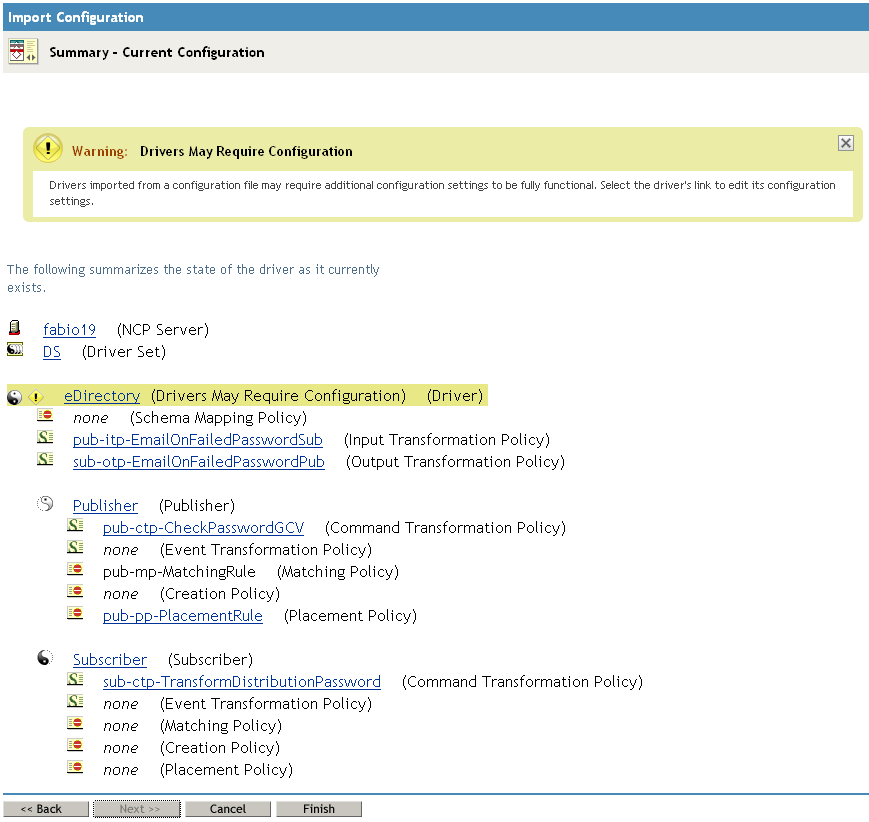3.2 Creating the Driver in iManager
You create the eDirectory driver by importing the driver’s basic configuration file and then modifying the configuration to suit your environment. After you’ve created and configured the driver, you need to start it. To connect two trees, you need to do this for the driver installed in each tree.
3.2.1 Importing the Driver Configuration File
-
In iManager, click
 to display the Identity Manager Administration page.
to display the Identity Manager Administration page.
-
In the Administration list, click to launch the Import Configuration Wizard.
-
Follow the wizard prompts, filling in the requested information (described below) until you reach the Summary page.
When you finish providing the information required by the wizard, a Summary page similar to the following is displayed.

At this point, the driver is created from the basic configuration file. To ensure that the driver works the way you want it to for your environment, you must review and modify (if necessary) the driver’s default configuration settings.
-
To modify the default configuration settings, click the linked driver name, then continue with Configuring the Driver.
or
To skip the configuration settings at this time, click . When you are ready to configure the settings, continue with Configuring the Driver.
3.2.2 Configuring the Driver
After importing the driver configuration file, the eDirectory driver will run. However, the basic configuration might not meet the requirements for your environment. You should complete the following tasks to configure the driver:
-
Secure the driver connection: eDirectory drivers communicate via SSL using digital certificates for authentication. You need to set up this secure connection. See Section 5.0, Securing Driver Communication.
-
Configure the driver filter: Modify the driver filter to include the object classes and attributes you want synchronized between the two eDirectory trees. For information about the classes and attributes include in the filter for the basic configuration, see Section B.0, Synchronized Attributes.
-
Configure policies: Modify the policies as needed. Policies should generally be placed only on the Publisher channel, not on the Subscriber channel. The Matching and Placement policies cannot operate correctly on the Subscriber channel because the Subscriber channel is acting primarily as a source of events for the Publisher channel of the other tree.
You might consider placing an Event Transform or Create Policy on the Subscriber channel to prevent sending unnecessary data across the channel. See
Using Scope Filtering to Manage Users on Different Servers
in the Identity Manager 3.6.1 Installation Guide. -
Configure password synchronization: The basic driver configuration is set up to support bidirectional password synchronization through Universal Password. If you don’t want this setup, see Section 6.0, Synchronizing Passwords.
After completing the configuration tasks, continue with the next section, Starting the Driver.
3.2.3 Starting the Driver
When a driver is created, it is stopped by default. To make the driver work, you must start the driver and cause events to occur. Identity Manager is an event-driven system, so after the driver is started, it won’t do anything until an event occurs.
To start the driver:
-
In iManager, click
 to display the Identity Manager Administration page.
to display the Identity Manager Administration page.
-
Click .
-
Browse to and select the driver set object that contains the driver you want to start.
-
Click the driver set name to access the Driver Set Overview page.
-
Click the upper right corner of the driver, then click .
For information about management tasks with the driver, see Section 7.0, Managing the Driver.